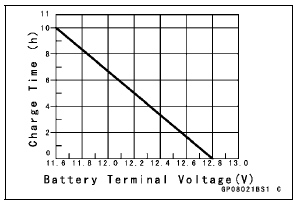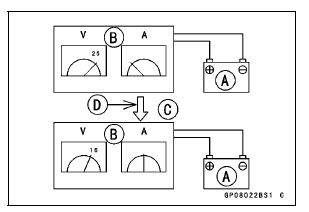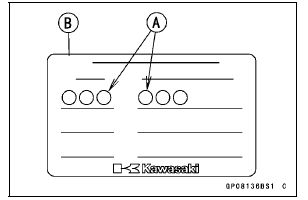

| WARNING This battery is sealed type. Charge with current and time as stated below. |
Terminal Voltage: 12.0  12.7
12.7
V
Standard Charge (see following chart):
ZX1000J: 0.6 A × 5  10 h
10 h
ZX1000K: 0.9 A × 5  10 h
10 h
Quick Charge
ZX1000J: 3 A × 5  1 h
1 h
ZX1000K: 4.5 A × 1 h

NOTICE
If possible, do not quick charge. If quick charge is done unavoidably, do standard charge later on.
Terminal Voltage: 12 V or lower Charging Method: 0.6 A × 20 h
Kawasaki-recommended chargers: Battery Mate 150-9
OptiMate PRO 4-S/PRO S/PRO 2
Yuasa MB-2040/2060
Christie C10122S
NOTE
Increase the charging voltage to a maximum voltage of 25 V if the battery will not accept current initially. Charge for nomore than 5minutes at the increased voltage then check if the battery is drawing current. If the battery will accept current decrease the voltage and charge by the standard charging method described on the battery case. If the battery will not accept current after 5 minutes, replace the battery.

Battery [A] Battery Charger [B] Standard Value [C] Current starts to flow [D].
Determine the battery condition left for 30 minutes after
completion of the charge by measuring the terminal voltage
according to the table below. 

 Charging Condition Inspection
Charging Condition Inspection Charging System
Charging SystemSwingarm Bearing Removal
Remove:
Swingarm (see Swingarm Removal)
Collar [A]
Oil Seals [B]
Sleeve [C]
Circlip [D] (Right Side)
Special Tool - Inside Circlip Pliers: 57001-143
Remove the ball bearing and needle bearings.
Special Tool - Oil Seal & Bearing Remover [A]: 57001-1058
...
Drive Chain
The drive chain slack and lubrication
must be checked each day before riding
the motorcycle and must be maintained
in accordance with the Periodic
Maintenance Chart for safety and to
prevent excessive wear. If the chain
becomes badly worn or maladjusted -
either too loose or too tight - the c ...
Brake Hose and Pipe Damage and Installation Condition Inspection
Inspect the brake hoses, pipes and fittings for deterioration,
cracks and signs of leakage.
The high pressure inside the brake line can cause fluid to
leak [A] or the hose to burst if the line is not properly maintained.
Bend and twist the rubber hose while examining
it.
Replace the ...